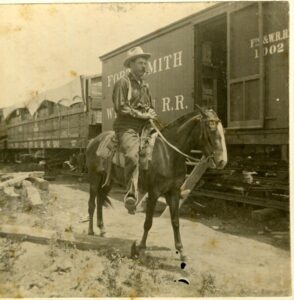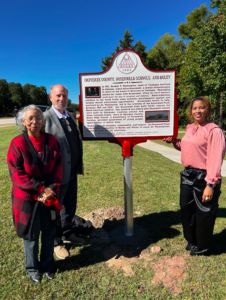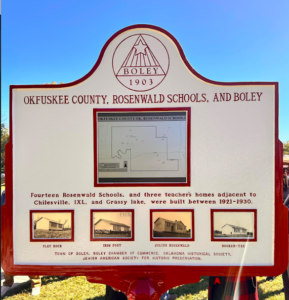By Jerry Klinger

Boley, Oklahoma, Creek Nation, Indian Territory, was established as an all-Black town on the land of Creek Indian “Freedwoman” Abigail Barnett in 1903. When the Five Tribes, Cherokee, Chickasaw, Choctaw, Muscogee (Creek), and Seminoles, were forcibly removed from their homelands in the 1830s–40s, people enslaved by the tribes also made the long journey to Indian Territory. By 1861, eight to ten thousand Black people were enslaved throughout Indian Territory. Ms. Barnett’s family was part of that story.
Boley was named in honor of J.B. Boley, a “White” man, as the historical marker on the main street around the corner from the Mayor’s office noted with dignity. J.B. Boley was the roadmaster for the Fort Smith and Western Railroad. He was convinced that Black Americans could govern themselves. Boley worked hard, successfully convincing the Railroad to share his vision. The Town of Boley was incorporated in 1905.
By 1911, Boley attracted many Blacks from throughout the South seeking to escape Jim Crow. The Town prospered. It was a haven of Black Enterprise, potential, and refuge from anti-Black bigotry. Its population rose to 4,200.
But Boley could not escape Jim Crow beyond the Town’s borders. Oklahoma became a State in 1907 and instituted Jim Crow. Black children were not permitted to be educated with White children. State and County educational resources were deliberately discriminated against Black education. Okfuskee County, outside of the Town, was primarily rural and poor. The benefits of educational funding for Black children were largely denied.

The Jewish American Society for Historic Preservation (JASHP) has been actively donating historical markers across the South, recognizing the unique mission of Julius Rosenwald and his partnership for Good with Dr. Booker T. Washington, the Black American President of the Tuskegee Institute. Rosenwald wrote in an unpublished speech, “The Jew must be a pillar of civic well-being and moral capacity. He must be the one who in every crisis will be right, militant for the right, the ethical, the spiritual, the best in national life.”
Placing a historical interpretive marker needs two key elements for success; a willing partner and time. JASHP approached Boley about donating a Rosenwald marker to the Town over a year ago. Amanda Bradford, on behalf of Boley, accepted the partnership with JASHP. She was the key link. She knew everyone, and everyone knew her.
Amanda wrote on the Boley Facebook page:
“Julius Rosenwald, in partnership with Booker T. Washington, made an indelible mark in African American education by building Rosenwald Schools across the South in the early 20th century. This marker, donated by the Jewish American Society for Historic Preservation and proudly supported by the Town of Boley, Chamber of Commerce, and the Oklahoma Historical Society, celebrates their enduring legacy Boley… these schools became beacons of hope during a time of segregation, providing education and opportunity to countless young minds.”
October 14, after many long, frustrating delays, the marker was dedicated. Boley proudly sited it next to the Boley Oklahoma Historical Society Marker adjacent to Boley’s Community Park, where it would have maximum visibility.
The Town wrote the text for the marker.
“In 1911, Booker T. Washington, head of Tuskegee Institute in Alabama, asked Julius Rosenwald, a Jewish Philanthropist, to serve on the board of directors at Tuskegee. Washington shared his vision with Rosenwald; lifting the veil of ignorance would point the way to progress and industry. Black-American children in the rural South were severely discriminated against and largely denied educational opportunities. Rosenwald’s desire to help, nurtured by Dr. Washington, led to the creation of the Rosenwald Fund. Between 1917 and 1932, the Rosenwald Fund built 5,340 schools for Black-American children. One hundred and ninety-nine Rosenwald schools were built in Oklahoma; fourteen schools and three teacher’s homes were in Okfuskee County. Boley High School, a beneficiary of Rosenwald funding, provided generations of young people opportunities to better lives.
Working through mutuality, commonality, and respect, the Rosenwald Fund linked local communities of Blacks and Whites to reach Dr. Washington’s vision of good for all Americans.”
 The reverse side of the marker has a siting map of the Rosenwald Okfuskee County schools and images of four representative schools. An image of Dr. Washington and Julius Rosenwald and Boley High School was included on the front.
The reverse side of the marker has a siting map of the Rosenwald Okfuskee County schools and images of four representative schools. An image of Dr. Washington and Julius Rosenwald and Boley High School was included on the front.
The dedication was attended by former Rosenwald students and the members of Boley’s and surrounding communities. All acknowledged that the Rosenwald schools had made a difference, then, today, and tomorrow, for all Americans, whatever color they may be.
Julius Rosenwald commented, “I do not see how America can go forward if part of its people (Black Americans) are left behind.”
He was right.
*
Jerry Klinger is the President of the Jewish American Society for Historic Preservation, www.JASHP.org.